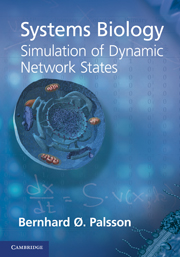Book contents
12 - Building networks
from PART III - METABOLISM
Published online by Cambridge University Press: 05 August 2012
Summary
Chapter 11 described the integration of two pathways. We will now add yet another set of reactions to the system. The AMP input and output that was described earlier by two simple reactions across the system boundary represent a network of reactions that are called degradation and salvage pathways. The salvage pathways recycle the nucleotide by reversing their degradation pathways. AMP degradation and salvage are low-flux pathways but have genetic defects that cause serious diseases. Thus, even though fluxes through these pathways are low, their function is critical. As we have seen, many of the long-term dynamic responses are determined by the adjustment of the total adenylate cofactor pool. In this chapter, we integrate the degradation and salvage pathways to form the core metabolic network in the red blood cell.
AMP metabolism
AMP metabolism forms a small sub-network in the overall red blood cell metabolic network. We will first consider its properties before we integrate it with the combined glycolytic and pentose pathway model.
The AMP metabolic sub-network AMP is simultaneously degraded and synthesized, creating a dynamic balance (Figure 12.1). The metabolites that are found in these pathways and that are over and above those that are in the integrated glycolytic and pentose pathway network are listed in Table 12.1. To build this sub-network, prior to integration with the glycolytic and pentose pathway network, we need consider a sub-network comprised of the metabolites shown in Table 12.2.
Information
- Type
- Chapter
- Information
- Systems Biology: Simulation of Dynamic Network States , pp. 224 - 242Publisher: Cambridge University PressPrint publication year: 2011
